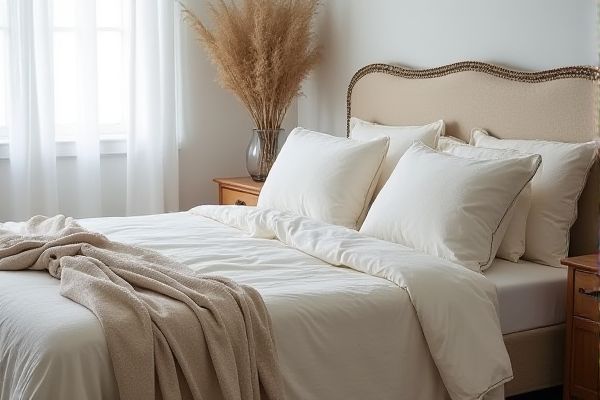
Linen slipcovers offer a breathable, natural texture that resists wrinkles and adds a sophisticated look, while cotton slipcovers provide softness, durability, and easier maintenance with a variety of color options. Explore the key differences to determine which slipcover material best suits your furniture and lifestyle needs.
Table of Comparison
| Feature | Linen Slipcover | Cotton Slipcover |
|---|---|---|
| Material | Natural flax fibers, breathable | Natural cotton fibers, soft |
| Durability | High durability, strengthens with use | Moderate durability, can wear faster |
| Texture | Textured, slightly crisp feel | Smooth, soft and flexible |
| Maintenance | Requires gentle washing, may wrinkle | Machine washable, less prone to wrinkles |
| Appearance | Natural, rustic, elegant look | Clean, casual, versatile style |
| Breathability | Excellent breathability, moisture-wicking | Good breathability, comfortable |
| Price | Generally higher cost | More affordable |
Introduction to Linen and Cotton Slipcovers
Linen slipcovers are crafted from flax fibers, offering natural breathability, durability, and a slightly textured, elegant finish ideal for both casual and formal settings. Cotton slipcovers, made from soft cotton fibers, provide a smooth, cozy texture with excellent stain resistance and ease of cleaning, making them perfect for everyday use in homes with children or pets. Both materials offer versatility and comfort, but linen excels in temperature regulation while cotton is favored for its softness and affordability.
Material Composition and Feel
Linen slipcovers are crafted from natural flax fibers, offering a breathable, textured fabric that softens with each wash and provides a relaxed yet elegant look. Cotton slipcovers, made from tightly woven cotton fibers, deliver a smooth, soft feel with high absorbency and durability, making them ideal for everyday use. Both materials are breathable and hypoallergenic, but linen's natural slubs and breezy texture create a distinct tactile experience compared to the more uniform surface of cotton.
Durability and Longevity
Linen slipcovers are renowned for their exceptional durability due to the natural strength of flax fibers, which provide resistance to wear and tear over time. Cotton slipcovers offer a softer feel but tend to wear out faster, especially with frequent washing, as cotton fibers can weaken and fade more quickly. Choosing a linen slipcover ensures greater longevity and maintains its structural integrity, making it a smart investment for your furniture.
Breathability and Comfort
Linen slipcovers offer superior breathability due to their natural fiber structure, allowing air circulation that keeps your furniture cool and comfortable, especially in warm climates. Cotton slipcovers provide a soft, cozy feel but tend to retain more heat and moisture compared to linen, which can affect overall comfort during long use. Choosing between linen and cotton slipcovers depends on your preference for cool airflow versus plush softness.
Maintenance and Washing Requirements
Linen slipcovers require gentle washing in cold water and air drying to preserve fabric integrity and prevent shrinkage, while cotton slipcovers tolerate more frequent machine washing at higher temperatures and can be tumble dried, making them easier to maintain. Linen naturally resists stains and wrinkles but may need occasional steaming to retain a smooth appearance, whereas cotton is more prone to creasing and may require ironing after washing. Both materials benefit from using mild detergents and avoiding bleach to extend the lifespan of the slipcovers.
Stain Resistance and Everyday Use
Linen slipcovers offer moderate stain resistance due to their natural fibers, which repel dirt but can absorb liquids quickly, requiring prompt cleaning to avoid stains. Cotton slipcovers excel in everyday use with higher durability and easier maintenance, often treated with stain-resistant finishes that enhance their ability to withstand spills and frequent washing. Choosing between linen and cotton slipcovers depends on balancing the desire for a breathable, textured fabric and practical stain resistance for high-traffic environments.
Aesthetic Appeal and Texture
Linen slipcovers offer a natural, slightly textured appearance with a matte finish that lends a sophisticated, relaxed elegance to your furniture. Cotton slipcovers provide a smoother, softer texture with a more uniform weave, creating a cozy and inviting look ideal for casual or traditional decor. Your choice between linen's breathable, rustic charm and cotton's crisp, versatile feel will significantly impact the overall aesthetic and tactile experience of your living space.
Color Options and Fading
Linen slipcovers offer natural, muted color options that develop a soft, unique patina over time, enhancing the fabric's character without intense fading. Cotton slipcovers provide a broader range of vibrant color choices but are more prone to fading when exposed to direct sunlight or frequent washing. Choosing a slipcover depends on whether you prioritize long-lasting, subtle tones or versatile, bold hues for Your space.
Cost Comparison
Linen slipcovers generally come with a higher price tag compared to cotton slipcovers due to the labor-intensive production process and premium quality of flax fibers. Cotton slipcovers are more budget-friendly, widely available, and offer good durability, making them an economical choice for most households. When considering long-term investment, linen's natural strength and wrinkle resistance may justify its initial higher cost through extended lifespan and maintained aesthetic appeal.
Which Slipcover is Best for Your Needs?
Linen slipcovers offer a breathable, durable, and naturally textured fabric ideal for a relaxed, elegant look, while cotton slipcovers provide a softer, more lightweight option with easy maintenance and a variety of color choices. Your decision should factor in the room's climate, usage frequency, and desired aesthetic, as linen excels in hot environments and high-traffic areas, whereas cotton suits casual, cozy settings. Considering durability and care preferences helps determine which slipcover material aligns best with your lifestyle and interior design goals.
 homyna.com
homyna.com